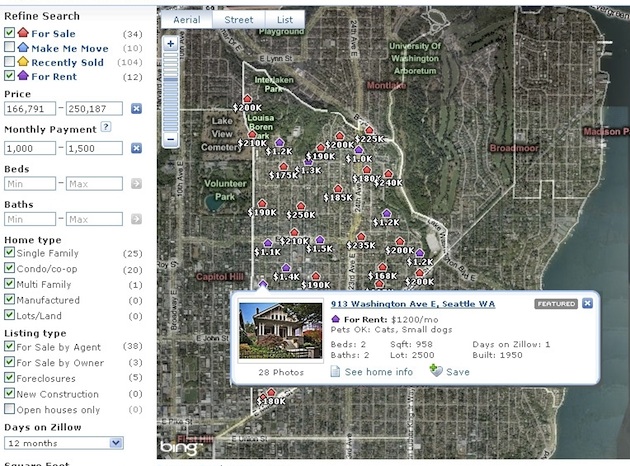
Real estate site Zillow says it’s already attracting 8.3 million monthly visitors who want to search for (and see the estimated value) of a new home. Now the Seattle company is moving into the rental market.
[aditude-amp id="flyingcarpet" targeting='{"env":"staging","page_type":"article","post_id":147136,"post_type":"story","post_chan":"none","tags":null,"ai":false,"category":"none","all_categories":"business,","session":"C"}']To be clear, Zillow won’t necessarily replace Craigslist when I decide to search for my next apartment. If you read the company’s blog post, it sounds like Zillow isn’t trying to become a general rental site but rather target a couple of specific audiences — homeowners who want to rent out their houses while they try to sell them (or until it’s a better market for selling), and shoppers who aren’t sure whether they want to rent or buy.
Zillow’s most interesting new feature should be a good fit for that second audience. Rather than forcing users to do an apples-to-oranges comparison between a home’s sale price and another home’s monthly rent, you can set a monthly payment range you can afford, and Zillow will bring up both for-sale and for-rent homes that fall in that range.
AI Weekly
The must-read newsletter for AI and Big Data industry written by Khari Johnson, Kyle Wiggers, and Seth Colaner.
Included with VentureBeat Insider and VentureBeat VIP memberships.
I went to the site to see what rentals I could turn up in Noe Valley (the San Francisco neighborhood where I live) or SoMa (where VentureBeat has its office). While there were plenty of sale listings, I ended up with zero rentals. In those neighborhoods, at least, potential renters will have to wait for homeowners to put up some rental listings.
Zillow has raised a total of $87 million in funding.
VentureBeat's mission is to be a digital town square for technical decision-makers to gain knowledge about transformative enterprise technology and transact. Learn More
